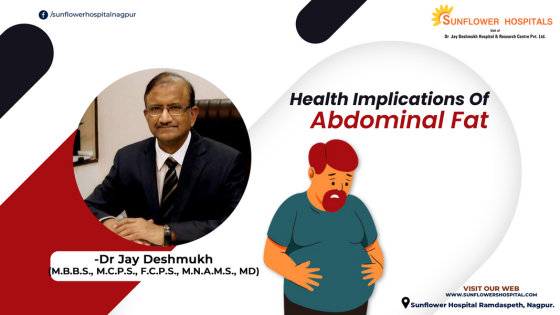Is belly fat more than skin deep?
The fat just below the skin is subcutaneous fat. Belly fat also includes visceral fat. The visceral fat lies deep inside the abdomen and surrounds the internal organs. This fat surrounds the vital organs like liver, pancreas and intestines. It is metabolically more active than subcutaneous fat and is linked to serious health issues
What are the newer insights into abdominal fat reduction and their advantages?
The advantages of weight reduction are linked not only to improving metabolic parameters like diabetes, hypertension and cholesterol but also to chronic pain and brain health. Visceral and subcutaneous fat are associated with widespread musculoskeletal pain, particularly in women. Problems related to memory are also linked with excess abdominal fat. Targeted weight loss around the waist has far reaching health implications. This decreases both pain and metabolic complications.
How to measure abdominal fat?
Using a measuring tape, for men waist circumference above 102 cm and 88 cm for women indicates increased risk. The waist-hip ratio is an another important and easy way to measure. A ratio above 0.90 in men and 0.85 in women is considered high. Skin fold calipers, DXA scans, CT and MRI of abdomen, bio electrical impedance analysis is other convenient and non invasive methods. In general waist circumference and waist-to-height ratio are practical and accessible methods.
Why are the risks of increased belly fat?
Regardless of overall weight, having a large amount of belly fat raises the risk of high blood pressure, high cholesterol and triglycerides in blood, increased cardiovascular risk, high blood glucose and diabetes, fatty liver, certain cancers, sleep apnoea, and stroke. High belly fat also leads to early death from any cause.
How much visceral fat is normal?
The normal visceral fat range should be about 10% of your body fat. If the total body fat percentage is higher than recommended, then the visceral fat range will be high too.
What causes visceral fat?
Environmental factors and genetic factors play a role here too. A high intake of fatty foods and carbohydrates and lack of exercise leads to abdominal obesity. Stress is a major factor too. Stress activates a hormone in the body called cortisol. This higher cortisol level triggers the storage of more abdominal fat.
What are the implications of abdominal fat?
Abdominal fat releases fatty acids and inflammatory molecules like cytokines that cause Insulin resistance. Hence, the body requires more Insulin to manage blood sugar. This is a precursor for type 2 diabetes. The visceral fat also increases the chances of heart disease, hypertension, and stroke, the abdominal fat raises blood pressure and cholesterol levels and causes increase cardiovascular disease. Abdominal fat also damages the liver leading to non-alcoholic fatty liver disease or NAFLD. This further increases the chances of cirrhosis of liver and liver cancer and also increases incidence of insulin resistance.Certain hormonal effects,lead to disruption of leptins and adinopectins leading to obesity and can make weight reduction difficult.
Is visceral fat difficult to lose?
In fact visceral fat is easier to loose than subcutaneous fat. It metabolises quicker than subcutaneous fat. If you start exercising regularly and eating a healthy diet, the results are seen. in about three months.

